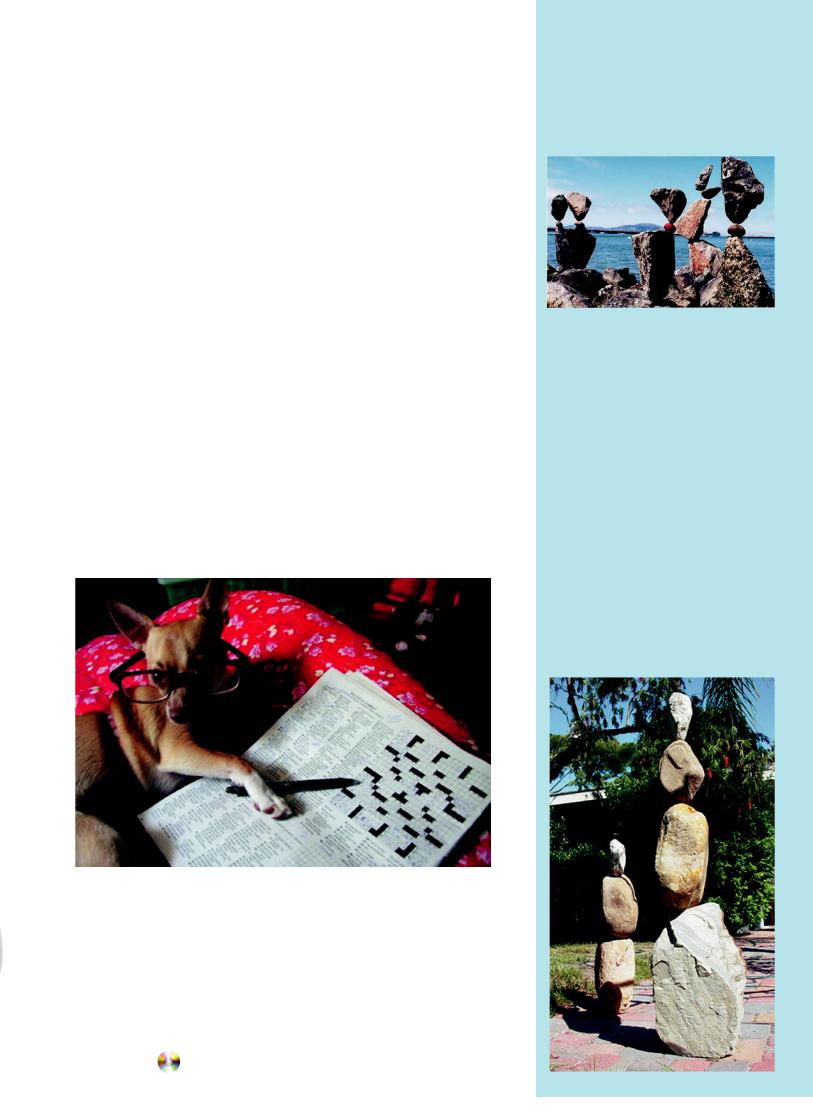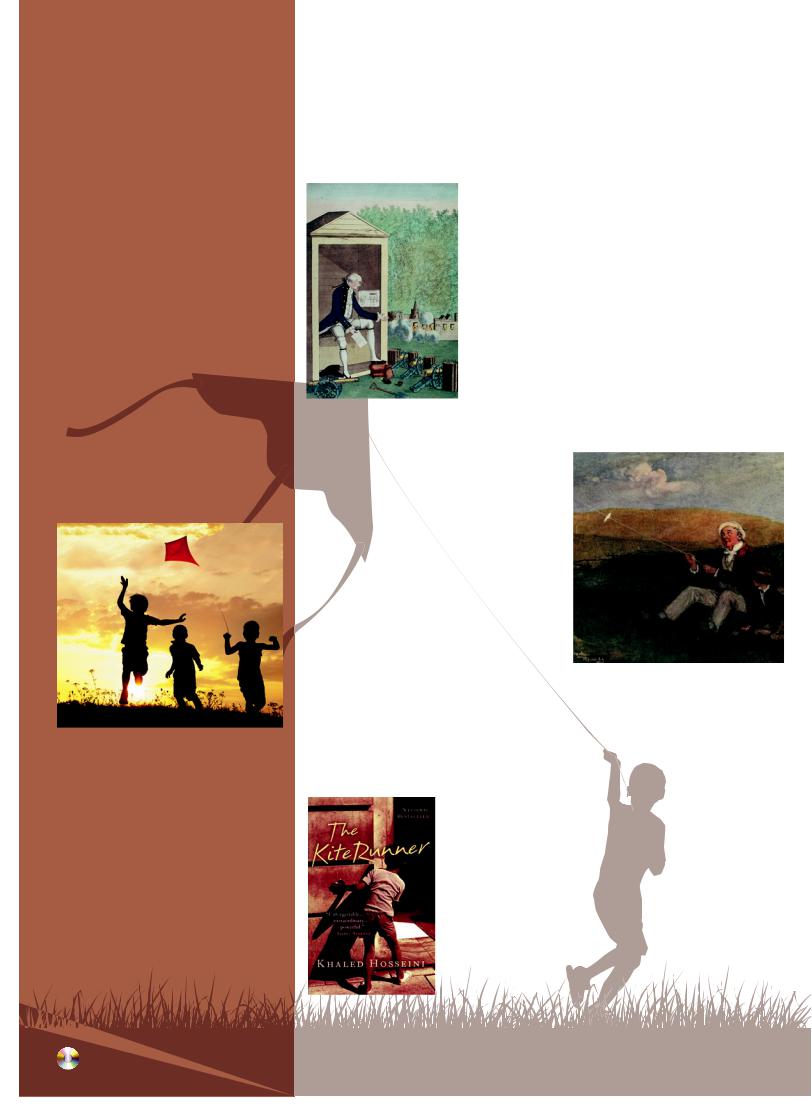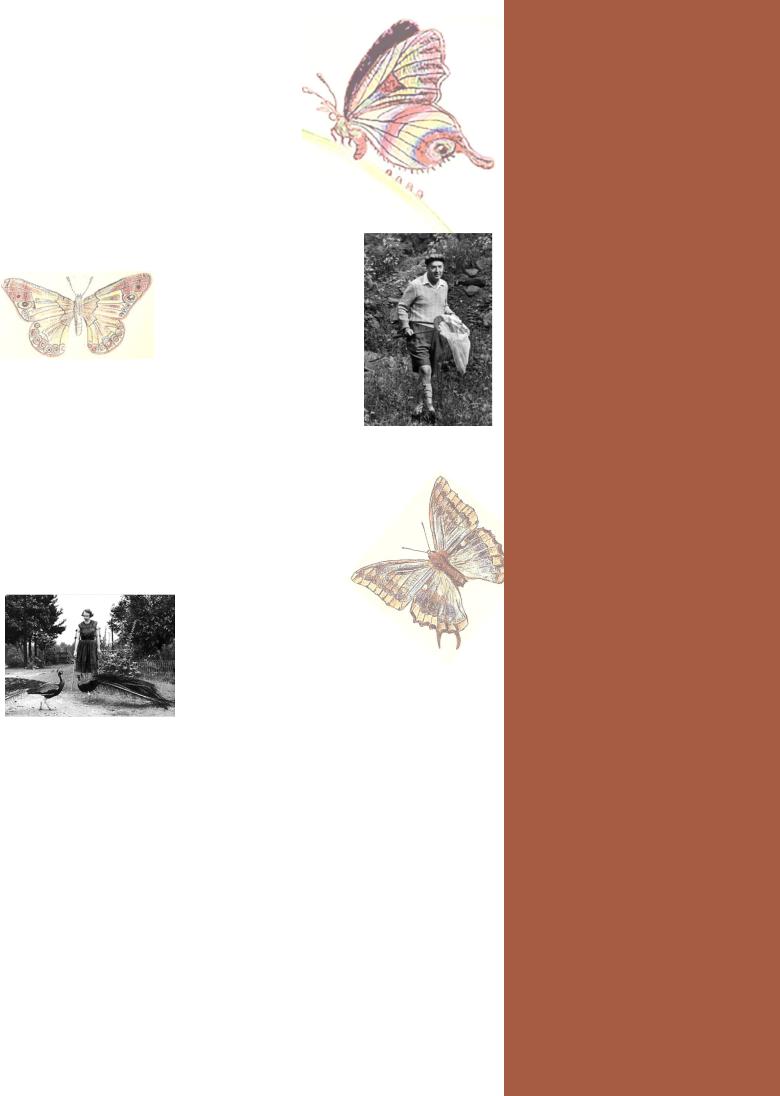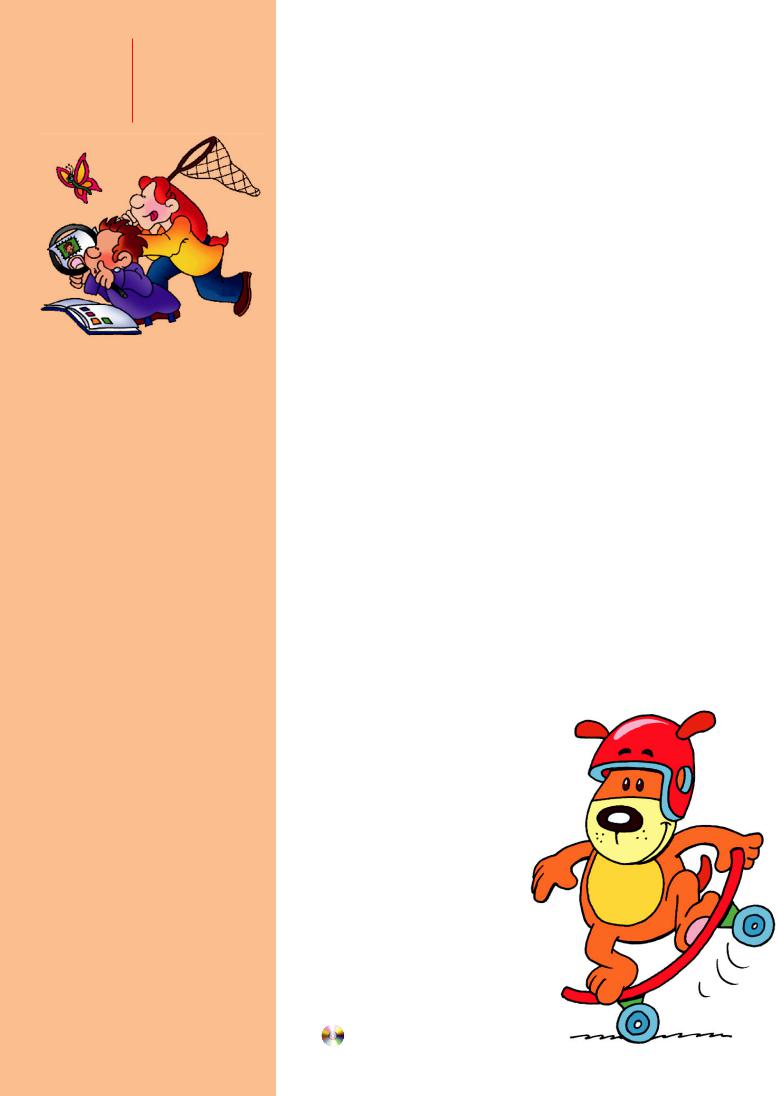
- •NEWS IN BRIEF
- •TEXTS FOR READING
- •London’s Newest Attraction and Symbol of Confidence
- •Impostor
- •METHODS OF TEACHING
- •CLASSROOM ACTIVITIES
- •English Club
- •CREATIVE WRITING
- •Hobbies Differ Like Tastes
- •FOCUS ON LANGUAGE
- •Crossword “Hobbies”
- •DISCOVERING THE PAST
- •Test Your Knowledge
- •LESSON PLANS
- •TOPICAL JOURNEY
- •Leisure Time in the Past
- •English Words and phrases for Free Time and Hobbies
- •Collecting as a Hobby
- •Interesting Facts
- •Creative Hobbies
- •Types of Hobbies
- •Popular Hobbies
- •Hobbies in Books
- •SCHOOL THEATRE
- •The Little Prince
- •PREPARING FOR EXAMS
- •My Hobbies
- •TESTS
- •Five-Minute Tests
- •FOR YOUNG LEARNERS
- •Primary School Olympiad
- •GOOD NEWS
- •YOUTH ENGLISH SECTION

|
TOPICAL JOURNEY |
|
English |
Popular Hobbies |
35 |
||
April 2013 |
|||
Popular hobbies listed are a good start to choosing a hobby which is something you should be proud of because it adds to your character, gives you something to talk about when you meet people making it easy to find out if you have something in common. What is your favourite hobby? Some people don’t even know that what they do in their relaxing time is a hobby. Here is a list on the most popular Hobbies.
1. Amateur radio |
21. |
Family Time |
41. |
Running |
||
2. Amateur Astronomy |
22. |
Fishing |
42. |
Sailing |
||
3. Animal Care |
23. |
Gardening |
43. |
Sewing |
||
4. Arts and craft |
24. |
Going to Movies |
44. |
Shopping |
||
5. |
Beach |
25. |
Golf |
45. |
Skiing |
|
6. |
Bicycling |
26. |
Hiking |
46. |
Sleeping |
|
7. |
Billiards |
27. |
Housework |
47. |
Socializing |
|
8. |
Boating |
28. |
Horseback Riding |
48. |
Swimming |
|
9. |
Bowling |
29. |
Home brewing |
49. Team Sports |
||
10. |
Camping |
30. |
Hunting |
50. |
Tasting/tea, koffie |
|
11. Casino Gambling |
31. |
Jigsawpuzzles |
51. |
Tennis |
||
12. |
Computer |
32. |
Kites |
52. |
Traveling |
|
13. |
Cooking |
33. |
Listening to Music |
53. |
Treasure hunting |
|
14. |
Church Activities |
34. |
Motorcycling |
54. |
Theater |
|
15. |
Crafts |
35. |
Painting |
55. |
Volunteer Work |
|
16. |
Crossword Puzzles |
36. |
Playing Cards |
56. |
Walking |
|
17. |
Dancing |
37. |
Playing Music |
57. Watching TV |
||
18. |
Eating Out |
38. |
Reading |
58. |
Watching Sports |
|
19. |
Entertaining |
39. |
Relaxing |
59. |
Woodworking |
|
20. |
Exercise |
40. |
Renting Movies |
60. |
Working on Cars |
|
|
|
|
|
|
61. |
Writing |
ROCK BALANCING
Rock balancing is an art, discipline, or hobby
(depending upon the intent of the practitioner) in which rocks are balanced on top of one another in various positions. There are no tricks involved to aid in the balancing, such as adhesives, wires, supports, or rings.
Rock balancing can be a performance art, a spectacle, or a devotion, depending upon the interpretation by its audience. Essentially, it involves placing some combination of rock or stone in arrangements which require patience and sensitivity to generate, and which appear to be physically impossible while actually being only highly improbable. The rock balancer may work for free or for pay, as an individual or in a group, and their intents and the audiences’ interpretations may vary given the situation or the venue.
Styles of rock balancing
•Pure balance – each rock in near-point balance.
•Counterbalance – lower rocks depend on the weight of upper rocks to maintain balance.
•Balanced stacking – rocks lain flat upon each other to great height.
•Free style – mixture of the two above; may include arches and sandstone.
See more at http://www.gravityglue.com
Hobby Fun
I’ve given up my parachuting hobby,
now I just go on google earth and use their zoom function. I used to time travel as a hobby when I was older....
I was walking along the beach with my metal detector when I found a metal box buried in the sand.
I opened it and found a small note that said: ‘Get a real hobby you dumb’.
If you spend money on it, it’s a hobby. If you make money on it, it’s a business.
http://yourhobbyfinder.com |
See additional materials on CD. |

English |
|
|
|
“My idea of a good time is reading a book.” |
|
|
TOPICAL JOURNEY |
||
36 |
|
|
|
Wodehouse |
|
|
Hobbies in Books |
||
April 2013 |
|
|
||
|
||||
The story by Somerset Maugham ‘The Kite’ tells about a man whose wife smashed his kite. He refused to provide for her and went to prison.
There is more in the story than just kite-flying so it is worth reading.
“What’s he in for?” I asked.
“He left his wife and the court ordered him to pay so much a week in alimony and he’s absolutely refused to pay it. I’ve argued with him till I was blue in the face. I’ve told him he’s only cutting off his nose to spite his face. He says he’ll stay in jail all his life rather than pay her a penny.
I tell him he can’t let her starve, and all he says is: `Why not?’ He’s perfectly well behaved, he’s no trouble, he works well, he seems quite happy, he’s just getting a lot of fun out of thinking what a devil of a time his wife is having.”
“What’s he got against her?” “She smashed his kite.”
“She did what?” I cried.
“Exactly that. She smashed his kite. He says he’ll never forgive her for that till his dying day.”
“He must be crazy.”
“No, he isn’t, he’s a perfectly reasonable, quite intelligent, decent fellow.”
The story ends like this: “In fact he’s smarter than the average. What d’you suppose there is in kite-flying that makes the damned fool so mad about it?”
“I don’t know,” I answered. I took my time to think. “You see, I don’t know a thing about flying a kite. Perhaps it gives him a sense of power as he watches it soaring towards the clouds and of mastery over the elements as he seems to bend the winds of heaven to his will. It may be that in some queer way he identifies himself with the kite flying so free and so high above him, and it’s as it were an escape from the monotony of life. It may be that in some dim, confused way it represents an ideal of freedom and adventure. And you know, when a man once gets bitten with the virus of the ideal not all the King’s doctors and not all the King’s surgeons can rid him of it. But all this is very fanciful and I dare say it’s just stuff and nonsense. I think you’d better put your problem before someone who knows a lot more about the psychology of the human animal than I do.”
lot more about the psychology of the human animal than I do.”
In the novel by Laurence Sterne The Life and Opinions of Tristram Shandy, Gentleman, (1760-7), the characters’ hobby-horses, or particular obsessions, are discussed in detail. Here, Uncle Toby’s obsession with the military leads to him and Trim – who gets caught up in Toby’s enthusiasm - to begin acting out military actions. The arts of fortification were Uncle Toby’s principal hobby.
Kite flying, or kite running in literature has taken place in a few books.
In Charles Dickens’ David Copperfield we meet angelic innocence personified in Mr Dick. When Miss Betsy Trotwood faces a deep problem that has to be solved, Mr Dick will always find a simple answer. When David first arrives at his aunt’s place, Miss Betsy addresses Mr Dick:” How can you pretend to be wool-gathering, Dick, when you are
as sharp as a surgeon’s lancer? Now, here you see young David Copperfield, and the question I put to you is, what shall I do with him?’ Of course, his answer would be a matter of survival. Under pressure to give a
sound answer, Mr Dick replies: ‘I should – I should wash him!’
In the end Miss Betsy always follows Mr Dick’s advice because in his humanness Mr Dick is never wrong: ‘Mr Dick sets us all right.’
Yet Mis Betsy, David Copperfield, and others know that Mr Dick is mad. His life is devoted to writing a Memorial of King Charles, a memorial that he destroys as soon as he writes it. Besides being a writer, Mr Dick is a manchild who delights in building and flying kites. One day Mr Dick invites David to go fly with him his new creation – a seven feet kite! The kite is covered with the very same manuscript that the innocent soul has written. ‘There’s
plenty of string,’ said Mr Dick,’ and when it flies high, it takes the facts a long way. That’s my manner of diffusing ‘em. I don’t know where they may come down. It’s according to circumstances, and the wind, and so forth, but I take my chance of that’.
In that magical dimension in which Mr. Dick lives, he foresees that words – which he calls facts – not only live, fly, soar, and travel in space, but also have consequences which a writer cannot foresee. In a century in which radio, TV, satellite, and other special communication was unknown, only a madman could have foreseen that.
“The Kite Runner” is a powerful novel by Khaled Hosseini, which was published in 2003. It was made into a movie in 2007. The novel tells about Amir, a young boy living in Kabul. His closest friend, Hassan, whose father is his father’s servant, shares his hobby of kite-running. The story is set in the midst of stormy events, from the fall of monarchy through the Soviet invasion, the exodus of refugees to Pakistan and the United States, and the rise of the Taliban regime. The kite-running at the beginning of the novel causes drama of humiliation and betrayal; in the final scenes it brings complete recovery to another unhappy child.
See full text on the CD. |
Compiled by Olga Sventsitskaya |

Famous
Hobbyists
SURPRISING HOBBIES OF FAMOUS AUTHORS
Though a recluse for most of her life, Emily Dickinson loved to bake, and would often lower a basket full of baked goods from her window to the children waiting in the street.
Vladimir Nabokov was an avid lepidopterist, once commenting, “The pleasures and rewards of literary inspiration are nothing beside the rapture of discovering a new organ under the microscope or an undescribed species on a mountainside in Iran or Peru. It is not improbable that had there been no revolution in Russia, I would have devoted myself entirely to lepidopterology and never written any novels at all.”
“My pleasures are the most intense known to man: writing and butterfly hunting.” ~ Vladimir Nabokov
Ayn Rand was a passionate collector of stamps, a hobby that seems altogether too mundane for her, as far as we’re concerned.
From an article she wrote on the subject: “The pleasure lies in a certain special way of using one’s mind. Stamp collecting is a hobby for busy, purposeful, ambitious people… because, in pattern, it has the essential elements of a career, but transposed to a clearly delimited, intensely private world.”
Mark Twain, most famous for a novel about a kid floating down a river on a super low budget raft, was actually obsessed with science and technology and was great friends with Nikola Tesla. He also invented (and patented) a device to replace suspenders, which he called an “Improvement in Adjustable and Detachable Straps for Garments.”
Not only was she a skilled (and published) cartoonist, but Flannery O’Connor was obsessed with birds, and raised over 100 peacocks (in addition to ducks, hens, geese and any other kind of bird she could get her hands on) at her family’s farm, her ancestral farm, Andalusia, in Georgia.
Sylvia Plath and Ted Hughes were beekeepers, a hobby that was reflected in many of Plath’s poems and seems to have stemmed from a desire to feel grounded. When asked in a 1962 interview if she often hung out with other writers, she responded, “I much prefer doctors, midwives, lawyers, anything but writers. I think writers and artists are the most narcissistic people. I mustn’t say this, I like many of them, in fact a great many of my friends happen to be writers and artists. But I must say what I admire most is the person who masters an area of practical experience, and can teach me something. I mean, my local midwife has taught me how to keep bees. Well, she can’t understand anything I write. And I find myself liking her, may I say, more than most poets. And among my friends I find people who know all about boats or know all about certain sports, or how to cut somebody open and remove an organ. I’m fascinated by this mastery of the practical. As a poet, one lives a bit on air. I always like someone who can teach me something practical.”
In addition to being an avid runner, which is fairly unusual (at least in lore) for an author, Haruki Murakami really, really loves jazz – to the tune of listening to it for ten hours a day for many years. In an essay, he wrote, “It may sound paradoxical to say so, but if I had not been so obsessed with music, I might not have become a novelist. Even now, almost 30 years later, I continue to learn a great deal about writing from good music. My style is as deeply influenced by Charlie Parker’s repeated freewheeling riffs, say, as by F. Scott Fitzgerald’s elegantly flowing prose. And I still take the quality of continual self-renewal in Miles Davis’s music as a literary model.”
TOPICAL JOURNEY |
|
English |
|
|
37 |
|
|
April 2013 |
“Legendary innovators like Franklin and Darwin all possess some common intellectual qualities – a certain quickness of mind, unbounded curiosity – but they also share one other defining attribute. They have a lot of hobbies.”
Steven Johnson
Winston Churchill laid bricks as a hobby, the perfect past-time for the “British bulldog”, known for his persistence. In his first report to the House of Commons he famously said, ““I have nothing to offer, but blood, toil, tears, and sweat.” He rallied England with his declaration,
“we shall fight on the beaches, we shall fight on the landing grounds, we shall fight in the fields and in the streets, we shall fight in the hills; we shall never surrender.”
Painting was a huge and lasting passion for
Winston Churchill. Painting played a prominent role in the last 40 years of Churchill’s life though there is little to indicate from Churchill’s early life that he had any particular talent for art. In fact before taking up painting as a hobby, Clementine is recorded as stating that Winston had never so much as visited an art gallery. Despite his late start, Churchill’s art went on to be highly acclaimed and Winston Churchill’s paintings have been exhibited around the world and continue to attract great attention today...and not justbecause of their famous artist! “I know of nothing which, without exhausting the body, more entirely occupies the mind” Wrote Churchill on painting.
To be really happy and really safe, one ought to have at least two or three hobbies, and they must all be real. It is no use starting late in life to say: “I will take an interest in this or that.” Such an attempt only aggravates the strain of mental effort. A man may acquire great knowledge of topics unconnected with his daily work, and yet hardly get any benefit or relief. It is no use doing what you like; you have got to like what you do.
Broadly speaking, human beings may be divided into three classes: those who are toiled to death, those who are worried to death and those who are bored to death. It is no use offering the manual labourer, tired out with a hard week’s sweat and effort, the chance of playing a game of football or baseball on Saturday afternoon. It is no use inviting the politician or the professional or business man, who has been working or worrying about serious things for six days, to work or worry about trifling things at the weekend.
As for the unfortunate people who can command everything they want, who can gratify every caprice and lay their hands on almost every object of desire – for them a new pleasure, a new excitement is only an additional satiation. In vain they rush frantically round from place to place, trying to escape from the avenging boredom by mere clatter and motion. For them discipline in one form or another is the most hopeful path.
|
From Winston Churchill’s |
http://flavorwire.com; http://quixoteconsulting.com |
selection of essays titled Thoughts and Adventures |

English |
TOPICAL JOURNEY |
38
April 2013
Unscramble the words and find out the hobbies and free time activities.
1.DNARPAGLIGI
2.HPISNGOP
3.GNIHUNT
4.MMIWINGS
5.CLYCGNI
6.GGJINOG
7.KSY RUGNSFI
8.INGNOEAC
9.SHECS
10.GINSGIN
11.LAYPGIN RTSAD
12.NASYGMICTS
13.BLEAT NNITSE
14.GNIDARW
15.GHTSDRAU
Choose the right options. Two are correct.
1.Which of the following are extreme sports?
a) scuba diving |
c) sleeping |
b) kitesurfing |
d) surfing the net |
2.Which of the following are indoor activities?
a) rock climbing |
c) horse riding |
b) darts |
d) karate |
3.They are played between two teams and a ball is required.
a) diving |
c) water polo |
b) running |
d) basketball |
4.Two of these are played on a board. Which?
a) draughts |
c) chess |
b) weightlifting |
d) skating |
Read the descriptions and find out the activities/sports.
1.I really enjoy looking for bargains.
2.It is played on a board with different shaped peaces, such as kings.
3.Jumping from a plane and floating slowly to the ground.
4.You need gloves, and poles to do it.
5.Trunks and a cap are required to practise it.
6.You cannot do this without oars.
Free Time
Activities
I LOVE SKATING
Hello, I’m Rusty, the skater.
I’m a special dog as you can see. And Maria is my owner. She is very young. She is only six years old. She has got black hair, brown eyes and a smiley face. She always carries with her a doll called Martha.
When her parents are out, I’m the one who takes care of her. She loves to play hide and seek all the time. But I prefer skating of course.
I skate with all my buddies of the neighbourhood and I am the best one. Sometimes Maria goes with me but she gets tired easily so I have to take her back home.
I usually wake up early to take her to the kindergarten at 8 0’clock. Then I come back home and have a nice breakfast: lots of bones. After that I say good bye to Maria’s parents: Joгo and Sara. Joгo is a doctor and Sara is journalist. He works for the local hospital here in S.joгo, and Sara works for the local newspaper.
They love me very much and that’s why I am responsible for Maria when they go out to the cinema.
During the day I do some housechores: dusting, washing, and so on…..
In the afternoon, I go for a walk with my girlfriend Patty. She lives two blocks away from me. We sometimes go to the nearest park and have fun swimming or running.
At about 5 0’clock we come back home. But first I go to Maria’s kindergarten and take her back home. Her mother is usual at home and that time and they chat a bit. Then I leave Patty home.
Finally I go skating for about three hours. I practice every day because during weekends we have competitions all over the country.
ACTIVITIES
A.Are these TRUE or FALSE?
1. Maria is Rusty’s owner.
2. She has got black hair.
3. She never smiles.
4. She has a doll called Stuart.
5. She only carries her doll after school.
6. Sometimes Rusty takes care of Maria.
7. Rusty usually plays with its neighbours.
8. Maria never goes with Rusty.
B.Answer these questions according to the text:
1. What colour are Maria’s eyes?
2. What does she like to play?
3. What time does Rusty take her to school?
4. What does Maria’s father do?
5. What’s her mother’s job?
6. Do they like Rusty?
7. What does Rusty do in the afternoon?
8. When does Rusty go skating?
C.What /Who do the underlined words refer to?
1. She
2. Her
3. They
4. She
D.Rewrite these sentences in the negative form:
1. I’m a special dog.
2. She is very young.
3. She is six years old.
4. I usually wake up early.
5. They love me very much.
6. He works for the local hospital.
See more activities on the CD.
